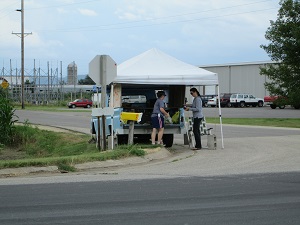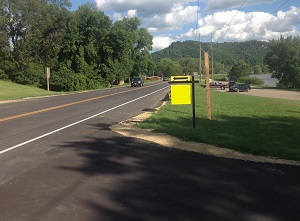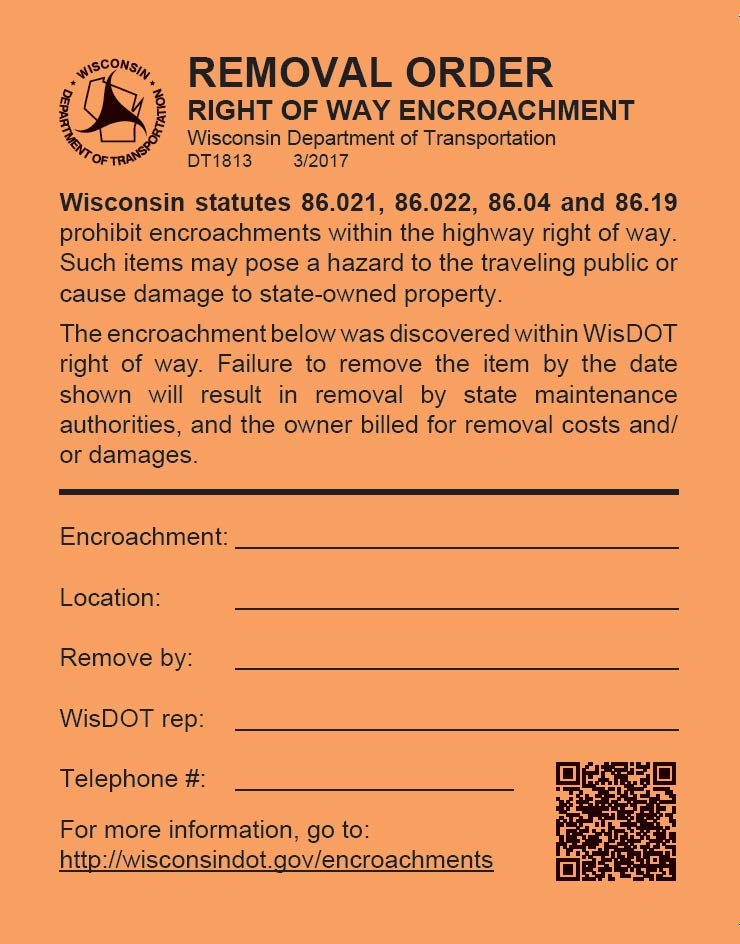An encroachment is any unauthorized object located partially or wholly within the state highway right-of-way. It includes, but is not limited to, items in the
categories below. Examples are also shown for reference.
Other types of encroachments include
unpermitted uses such as driveways, off-road vehicle paths, parking lots, and sidewalks.
What is the highway right-of-way?
The highway right-of-way is the area needed for traffic lanes, shoulders, ditches and errant vehicle recovery. On a rural 2-lane highway, some people assume this distance is 66 feet. This is not true in many situations. Only when no government acquisition records exist, state law (for nearly the last century)
presumes the government owns a 66-foot wide right-of-way as an easement.
Most state highways, however, are much wider than 66 feet. In fact, it is not unusual for highway right-of-way to be irregularly shaped, or for the roadway itself to not be centered in the right-of-way depending on the highway's operational and maintenance needs.
Interstates and freeways have a wider right-of-way than 2-lane highways, which can be anywhere from 200-300 feet on average. WisDOT highway fences are not "boundary" fences but rather "security" fences, which are installed to deter access from people and vehicles. Generally, they are a minimum of 3-5 feet on the roadway side of the right-of-way line.
In urban areas, boulevard medians, traffic lanes, bike lanes, curb & gutter, terraces, and sidewalks are part of the right-of-way. Also, there are locations in some urban areas where WisDOT's right-of-way extends right to a building foundation or wall of an adjoining property.
For examples of rural 2-lane, interstate/freeway, and urban right-of-way typical sections, see
drawings.
How do I know where the right-of-way is?
Contact the real estate section in a
WisDOT transportation region office to request a right-of-way plat. For complete accuracy, hire a registered land surveyor to check existing land records and physically establish the right-of-way boundary adjacent to your property. This is the best way to prevent encroachments.
Encroachment risks
Encroachments may pose potential safety hazards to motorists, cause damage to state property, or lead to claims of adverse possession. Both of the encroachments below block critical sight distance at intersections.


Property owners that fail to remove encroachments in a timely manner when directed by WisDOT may be subject to penalties pursuant to Wis. Stat.
s. 86.04,
s. 86.021, and
s. 86.022, and may be liable for treble (triple) damages pursuant to Wis. Stat.
s. 86.02. In addition, a person injured by an illegal encroachment in a highway accident may have a claim for damages against the person held accountable for the encroachment.
Mailboxes
Mailboxes and newspaper tubes along with their supports are encroachments that are typically allowed in the right-of-way. Since their general location is adjacent to the shoulder or curb, it is highly likely that vehicles will strike them. Therefore, they must be built to break away or yield if struck to protect the safety of the motoring public. Highway authorities follow similar guidelines when constructing road signs. For example, holes are commonly drilled through 4" x 6" wood posts near their base so they will break at the hole in the event of an crash.
Examples of hazardous mailboxes:
Examples of good installations:
Mailboxes constructed or protected with materials such as bricks, milk canisters filled with concrete and/or rocks, large timbers, or utility poles create a hazard. Property owners may receive a letter from WisDOT to remove the hazardous mailbox and replace it with an acceptable installation. See
Mailbox Safety to learn about safe mailbox construction. If these standards are violated, property owners may be liable for injuries caused by the improperly constructed mailbox and/or support(s).
Improperly placed signs
Advertising signs are prohibited on WisDOT right-of-way and are subject to immediate removal. These include political/campaign signs. See
improperly placed signs for additional information regarding this encroachment type.
WisDOT policy
WisDOT and county highway departments (working under contract to perform WisDOT maintenance) are responsible for removing encroachments from state highways. WisDOT will generally take action to remove encroachments shortly after discovery, which may occur during routine maintenance operations, prior to or during a highway improvement project (especially if WisDOT acquires new land with the project), or when brought to WisDOT's attention by an accident, occurrence or complaint.
Encroachments that are moveable objects may simply be removed from the right-of-way. Sometimes, these items will be moved onto an abutting property owner's land. Encroaching vehicles might be ticketed and/or towed. Fixed objects, pavements and portable items that are more difficult to move may lead to WisDOT issuing a removal order.
Sometimes, WisDOT does not take action to remove an encroachment. When this occurs, it may be that WisDOT is unaware of the encroachment, or has determined that it does not interfere enough with the safety, operation and maintenance of the highway to have it removed. This lack of action should not infer that the encroachment is harmless.
Revocable occupancy permit
 When there are unusual circumstances and typically in urban areas, a
revocable occupancy permit may be issued for an
existing encroachment, which will allow the encroachment to remain. The issuance of a revocable occupancy permit is treated as an exceptional case and not the rule or policy. An encroachment is allowed to remain by permit if all of the following criteria are met, i.e., the encroachment:
When there are unusual circumstances and typically in urban areas, a
revocable occupancy permit may be issued for an
existing encroachment, which will allow the encroachment to remain. The issuance of a revocable occupancy permit is treated as an exceptional case and not the rule or policy. An encroachment is allowed to remain by permit if all of the following criteria are met, i.e., the encroachment:
- will not impair highway function or maintenance, or interfere with the safe and free flow of traffic,
- is of a permanent nature or is actively used and properly maintained, and
- does not conflict with the broader public interest.
Notwithstanding the above criteria, a revocable occupancy permit may not be issued for a free-standing sign or outdoor advertising structure located totally within WisDOT right-of-way. By contrast, in an urban area where the highway extends to the edge of a building, WisDOT may permit a small sign attached to a building that overhangs the right-of-way (typically over a sidewalk). This sign would advertise the business(es) housed in the building.
Occupying excess right-of-way or property (land)
WisDOT occasionally owns more land than it needs for an existing state highway. For example, where a freeway is planned, WisDOT may purchase enough land for the freeway and only build two lanes initially. The remaining land is left idle until the other lanes are constructed. Generally, lands reserved in that manner would be expensive to repurchase if sold. WisDOT will sometimes rent such lands for parking or other temporary uses that will not interfere with eventual use of the lands for highway purposes. Market rental rates are assessed. In these situations, a lease is used in lieu of a revocable occupancy permit.
 For more information
For more information
Questions regarding the use of highway lands should be directed to the real estate section in the appropriate
WisDOT transportation region office.
If WisDOT is planning a new highway project, one of the early steps in the process is to identify and remove highway encroachments. A WisDOT representative will contact a property owner if encroachments are discovered prior to or during a highway improvement project. During the project, the WisDOT project manager on the construction site can take direct questions.
Encroachments discovered during routine maintenance operations may have an encroachment removal order placed on the item. The removal order will be in the form of an orange sticker and will have the name and telephone number of the WisDOT representative to contact for more information.